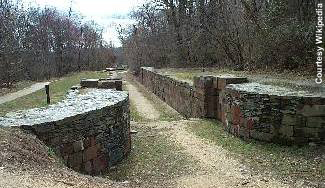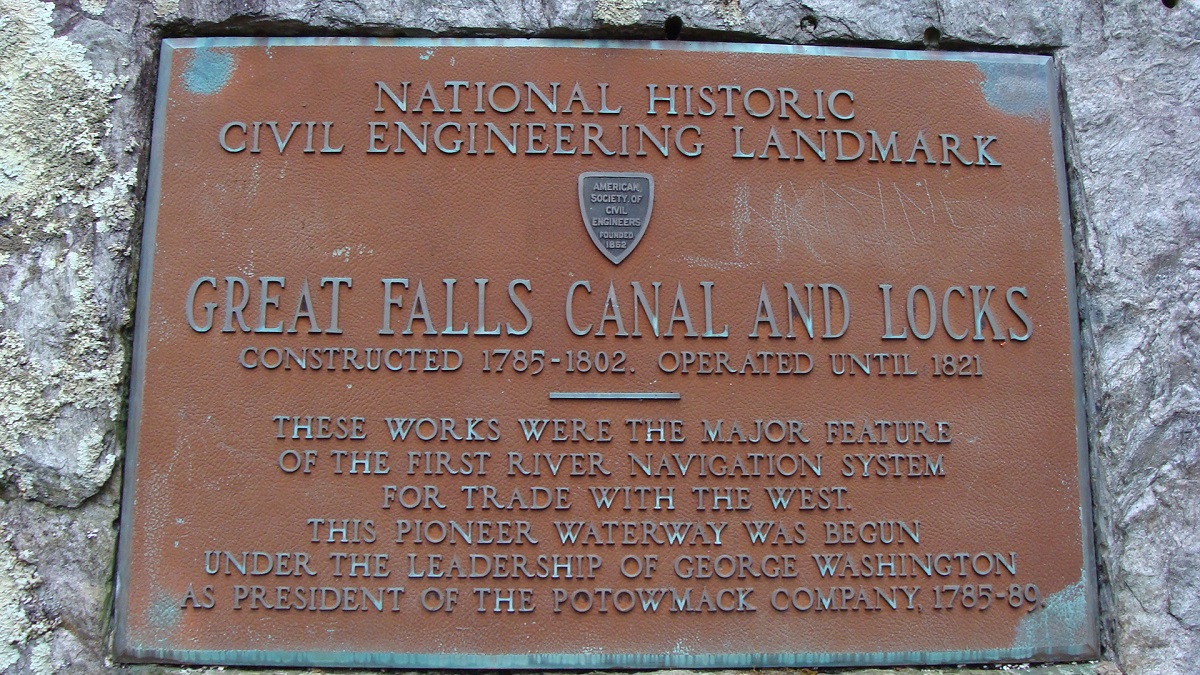Great Falls Canal and Locks
38 59 25.3 N
77 14 58.1 W
 Great Falls Canals and Locks
Great Falls Canals and Locks
"Thus, Sir, as far as I was capable, have I given you an acct. of the Conveniences and inconveniences that attend the Navigation of Potomack fr'm the Fall up, which I doubt but you will readily concur with me in judging it more convenient, least expensive, and I may further say, by much the most expeditious way to the Country."
- George Washington (to Thomas Lee), Aug. 1754
In the years immediately following the American Revolution, nearly one-half of the U.S. population lived west of the Appalachians -- but trade access to eastern ports proved difficult. As a young surveyor, George Washington had explored the upper reaches of the Potomac River and continued to believe throughout his life that it was possible to link the rapidly expanding frontier to markets on the East Coast at the headwaters of the Potomac and Ohio rivers.
In 1785, based on that belief, he organized The Potowmack Company to develop the river for commercial navigation. The company built a series of five canals, the most ambitious of them located at Great Falls, Virginia, where the the Potomac River drops nearly 80 feet. Passage there required the construction of five consecutive locks, the last three blasted out of solid rock. While the Great Falls Canal was abandoned in 1828, and river navigation to the frontier by that route was never achieved, the project started the great era of canal building essential to the growth of early America.
Facts
1. Washington served as The Potowmack Company's first president -- frequently overseeing the on-going survey and construction work himself -- until his election as the first President of the United States in 1789. By convincing the states of Maryland and Virginia in 1785 to jointly charter The Potowmack Company, he anticipated the issue of interstate commerce addressed at the Constitutional Convention of 1787.
2. Each lock of the Great Falls Canal was approximately 12-14 feet wide and 100 feet long. The upper locks of the canal were made of red Triassic sandstone, hand-hewn into large blocks and floated down river. Preceding the locks was an extensive mooring basin. Also, because the lower locks required more water, a separate supply basin, fed by the mooring basin, was built alongside the middle lock. The lower locks, cut through solid rock, were made possible by one of the earliest applications in the U.S. of gunpowder used for blasting.
3. The efforts of the Potowmack Company covered the Potomac River from Cumberland, Maryland, to Georgetown, Virginia, with the traffic of double-ended river boats and flat-bottomed rafts. In 1811, the company's best year, more than 1,300 vessels carried 16,350 tons of goods with a total estimated value of more than $925,000, delivering The Potowmack Company almost $23,000 in tolls. But developing the Potomac for river trade had cost a total of $750,000, an enormous sum at the time, and several years of drought and unexpected floods cut severely into the company's revenues. By 1821, The Potomack Company found itself $175,000 in debt and unable to secure any more credit.
4. In 1824, The Potomack Company's assets were transferred to the Chesapeake and Ohio Canal Company, which planned to build a 185-mile, continuous channel waterway alongside the Potomac. Construction for the Chesapeake and Ohio Canal began in 1828, and the locks built for the Great Falls Canal were closed the same year. The Chesapeake and Ohio Canal, which never reached beyond Cumberland, Maryland, operated until 1924 and today serves as the key element of the Chesapeake and Ohio Canal National Historical Park and recreational area.


